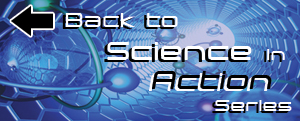
Heidi Nichols, a forensic photographer with the Miami-Dade County Medical Examiner's office
A vehicle hit and killed a pedestrian in Florida’s sprawling Miami-Dade County. Police searched for evidence of the perpetrator.
The medical examiner noticed the body had a faint bruise in the shape of a circle. Investigators at the office are accustomed to searching for pattern injuries like bruises and bite marks. With the use of a device that provides alternative light sources, they could see the circle was a Kia logo. That identified the vehicle make.
The team used a CrimeScope CS-16-500W, made by SPEX Forensics, a division of HORIBA Scientific. It’s the office’s workhorse. The CrimeScope CS-16-500W is an alternative light source which enhances the visibility of the subcutaneous bruising on the body. Blood absorbs the light and gets darker, and creates a contrast between the damaged skin and healthy skin. That brought out the pattern of the Kia logo.
Alternative light sources are typically used in crime scene investigation and post mortem examinations to identify many forms of evidence. Utilizing ultraviolet light, investigators can identify physiological fluids like semen, urine, and saliva through the fluids’ natural fluorescent properties. Various wavelengths can identify other characteristics of the evidence.
The Miami-Dade County Medical Examiner Department’s Forensic Imaging Bureau frequently uses alternative light sources to identify and illuminate evidence. And no one uses it more than its team of four photographers, including 20-year veteran and Senior Forensic Photographer Heidi Nichols.
She and the other photographers are part of a team that investigates deaths in the jurisdiction, along with the doctors, detectives and other forensic professionals.
“The majority of our time is spent photographing anatomical findings during the autopsy for the cause and manner of death, and any evidence that comes in,” Nichols said.
The medical examiner, a doctor who is a medical subspecialist must determine the cause and manner in the case of a death. The cause is what lead to the death. It might be a gunshot wound, car accident or heart attack. The manner describes how that death is classified. That would be either homicide, suicide, accidental death, natural causes or undetermined.
In another case, of a rape-homicide, the Miami-Dade County Medical Examiner Department used an alternative light source to search for bodily fluids. In that case, the light sources helped reveal that the victim was raped by multiple offenders.
“We are blessed to have this equipment,” Nichols said. “Other departments in Miami-Dade County don’t have them, so they ask us for it because we have the equipment.”
Over 2.7 million people call Miami-Dade County home. The medical examiner’s office covers 34 municipalities and performs about 1,800 autopsies a year. Its photographers take roughly 120,000 images a year.
The photographs, enhanced by the CrimeScope and other SPEX Forensics instruments can be used as evidence in a criminal trial.
Bruising from a bite mark as viewed under the SPEX Forensic CrimeScope CS-16-500W
Last year, the Miami-Dade County Medical Examiner Department investigated over 13,000 deaths. Of those, 2,532 cases came to the office and 1,839 were autopsied. That included 231 homicides, 260 suicides, 1,144 accidents other than traffic accidents, 226 traffic deaths and 859 deaths from natural causes.
At times, photographers at the medical examiner’s office are asked to image crime scene evidence where the investigating law enforcement agency doesn’t have the equipment. The outside agency might also bring the medical examiner’s unit a piece of evidence to photograph under the CrimeScope.
“Either they don't have the equipment or they're just having a hard time imaging it,” Nichols said. “And since we're strictly photographers and really good with our cameras, we can image that pretty well.”
Despite the tragedy Nichols witnesses on a daily basis, she’s found a way to deal with it.
“I think I'm just really good at compartmentalizing,” she said. “I definitely don't take the cases home with me. I think about the work. Of course, in my span of 20 years, I definitely had different cases that have stuck with me a little bit longer or are harder to work through. One of the cases involved police officers that I knew. They were shot and killed executing a search warrant. Working that scene was really tough. Seeing kids that are victims of very violent crime are always very difficult. And emotional.”
Among her arsenal of tools, Nichols also uses the SPEX Forensics HandScope LED, which it recently received. It is the only LED unit that changes and selects wavelengths like a forensic light source. The unit contains five wavelengths, providing coverage across the entire spectrum.
In addition, the office has a SPEX Forensics FOCUS LED, where it’s homogeneous spot and defined edge provides the consistent intensity necessary to properly capture photos where there are no under or over-developed sections in the same image. Despite its compact design, any crime scene can be searched with the same uniform illumination as that of a larger lab-based light source.
The Miami-Dade County Medical Examiner Department uses the FOCUS LED mostly for searching, Nichols said.
Semen stains, invisible to the naked eye, shows up clearly under alternative light sources
“And then once we say, okay, we found something, then we'll bring in the brighter CrimeScope. Because it works so well for photography. So we have much better exposures with the brighter light.”
Nichols expects the HandScope will be a combination of the CrimeScope and FOCUS LED.
“It’s the best of both worlds,” she said. “It will be even brighter. So we'll have better exposures, but have the portability as well.”
Nichols didn’t start off to be a forensic photographer. A Maine native, she wanted to study marine biology. She went to Barry University in Miami, Florida, near the warmer waters. Nichols took a photography class so she could learn to shoot underwater habitats. Her professors encouraged Nichols to switch her major, but she doubted she could make a living in that field.
Then she noticed the school offered a program in forensic photography. It combined her love of science with that of photography. An internship later at the medical examiner’s office and she was on her path to becoming a forensic photographer.
Nichols gets a lot of satisfaction out of working on a team and helping to solve crimes.
“Everybody has sort of their specialty and their expertise,” she said. I love those CSI (crime scene investigations) shows, but one thing that drives me a little crazy about those is that the same character is processing the scene, interviewing suspects, processing their own lab work, DNA and toxicology back at the lab. Then they're making the arrest. That’s taking like nine people’s specialties and wrapping it all into one person.”
Nichols never gets tired of the work.
“Every day, it's different. Every case is just so unique,” she said. “Even though if it's another gunshot wound, it's always different. And really, honestly, it's never boring.”

HORIBA제품의 자세한 정보를 원하시면, 아래의 양식에 내용을 입력을 부탁드립니다.


